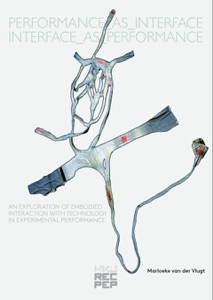NOTE: This website is about van der Vlugt’s artistic work till around 2021 - a new website is under construction. For recent works and writings related to van der Vlugt’s artistic PhD research, go to the Research Catalogue Page: Interactive CV
This front page is dedicated to the book:
Performance as Interface | Interface as Performance
An exploration of embodied interaction with technology in experimental performance
Performance as Interface | Interface as Performance is written by artist-researcher Marloeke van der Vlugt. It's a personal reflection on six years of artistic practice, in which she explores her living in a technology driven, networked world and its impact on the body. Van der Vlugt describes and reflects on a variety of her works, while taking the reader on the winding path of creation. By opening up her artistic processes, she invites the reader to explore his or her personal view on the topic while suggesting possible directions for the translation of human computer interaction within the performing arts. Moreover the title suggests a direction for further practical research what 'Performance as Interface' could entail for didactic purposes, design questions and beyond.
The selection of works consists of the videofilm MyCave, the performance AkiAnne, the performative installation Series Patchmaker, the collaborative dancework Duetten and the interactive sculptures PPI_I,2,3. They all have a similar starting point; they attempt to facilitate the audience to experience and dissect their 'performance of interaction' with technology. To what extent are we aware of our ‘performance’ in this technologically driven world? What does it mean when the body gets extended, hybridised and delimited through technology? How does meaning emerge in and through the body? What is the value of corporeality while interacting in a mediated manner with each other?
----
As a theatre maker van der Vlugt has been creating performances and interactive installations that enable the participant to experience how technological interaction is built and subsequently impacts our communication. The participants are invited to alternate the position of performer and spectator, which enables them to unveil, sense and discuss actual emerging body concepts. Starting from this physical experience, critical questions about larger themes as Identity, Human Enhancement and Communication, all in relation to technology, must be addressed from a personal perspective.
In this book, the different processes leading up to these works are described, zooming in on the way technological interaction is built, and how it impacts our communication. The reader is taken step by step through the various creation processes that exemplify how to come from the very first idea to the finished work. Each chapter starts with a personal idea that is displayed in excerpts taken from diaries and other short writings. The next phase translates this initial idea into a practical (often imaginary) concept that subsequently gets visualised with models, inspirational pictures and draft fragments of subsidy applications. Including the many considerations and choices made during this process, the description slowly leads to practical designs, reports of rehearsals with performers and/or building processes documented by scripts, drawings and photos. Finally the outcome is described and discussed at the end of every chapter.
The intention of van der Vlugt is to invite, among others, theatre, visual artists and performance makers interested in using technology to communicate with an audience, interaction designers looking for ways to involve and challenge the perception of our whole physical body and educators who feel it’s important to critically address how we use, develop and (re)stage the technology that surrounds us on the path of creation. In doing this, the readers are challenged to formulate their own ideas about the question what may happen when the body gets extended, hybridised and delimited through technology and to translate this into practical solutions with ample attention for both technology and the human body.
The form of the book already triggers the reader to engage oneself in different ways. Some photos are augmented with online audio recordings of the live impressions of the different works. Like this the texts and audio tracks are related: when reading and listening together, the audio recreates the specific ambiance of the work described and most likely influences the process of reading, like speed, and vice versa. For this, a headset and smart phone with the App ‘Layar’ installed is required.
---
Order at BOL.com and Theatre Book Shop
---
To comment or get in contact, please visit the Facebookpage: Performance as Interface.
---

